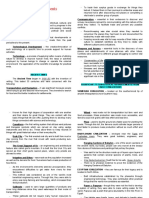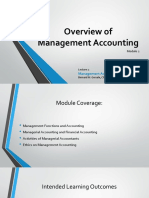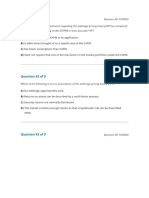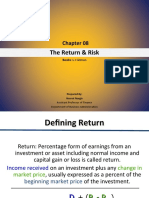0 ratings0% found this document useful (0 votes)
99 viewsChapter - 11 Portfolio Management
Chapter - 11 Portfolio Management
Uploaded by
D2NPortfolio management refers to selecting investments and managing them to maximize returns based on an individual's risk tolerance and time horizon. There are several types of portfolio management including active, passive, and discretionary. Performance is measured using metrics like the Sharpe ratio, Treynor ratio, and Jensen's alpha, which compare the portfolio's risk-adjusted returns to benchmarks.
Copyright:
© All Rights Reserved
Available Formats
Download as DOCX, PDF, TXT or read online from Scribd
Chapter - 11 Portfolio Management
Chapter - 11 Portfolio Management
Uploaded by
D2N0 ratings0% found this document useful (0 votes)
99 views5 pagesPortfolio management refers to selecting investments and managing them to maximize returns based on an individual's risk tolerance and time horizon. There are several types of portfolio management including active, passive, and discretionary. Performance is measured using metrics like the Sharpe ratio, Treynor ratio, and Jensen's alpha, which compare the portfolio's risk-adjusted returns to benchmarks.
Original Description:
investment bbs 4th year
Original Title
Chapter -11 Portfolio Management
Copyright
© © All Rights Reserved
Available Formats
DOCX, PDF, TXT or read online from Scribd
Share this document
Did you find this document useful?
Is this content inappropriate?
Portfolio management refers to selecting investments and managing them to maximize returns based on an individual's risk tolerance and time horizon. There are several types of portfolio management including active, passive, and discretionary. Performance is measured using metrics like the Sharpe ratio, Treynor ratio, and Jensen's alpha, which compare the portfolio's risk-adjusted returns to benchmarks.
Copyright:
© All Rights Reserved
Available Formats
Download as DOCX, PDF, TXT or read online from Scribd
Download as docx, pdf, or txt
0 ratings0% found this document useful (0 votes)
99 views5 pagesChapter - 11 Portfolio Management
Chapter - 11 Portfolio Management
Uploaded by
D2NPortfolio management refers to selecting investments and managing them to maximize returns based on an individual's risk tolerance and time horizon. There are several types of portfolio management including active, passive, and discretionary. Performance is measured using metrics like the Sharpe ratio, Treynor ratio, and Jensen's alpha, which compare the portfolio's risk-adjusted returns to benchmarks.
Copyright:
© All Rights Reserved
Available Formats
Download as DOCX, PDF, TXT or read online from Scribd
Download as docx, pdf, or txt
You are on page 1of 5
What is Portfolio Management ?
The art of selecting the right investment policy for the
individuals in terms of minimum risk and maximum return is
called as portfolio management.
Portfolio management refers to managing an individual’s
investments in the form of bonds, shares, cash, mutual funds
etc so that he earns the maximum profits within the stipulated
time frame.
Portfolio management refers to managing money of an
individual under the expert guidance of portfolio managers.
Types of Portfolio Management
In a broader sense, portfolio management can be classified under 4 major
types, namely –
Active portfolio management
In this type of management, the portfolio manager is mostly concerned
with generating maximum returns. Resultantly, they put a significant share
of resources in the trading of securities. Typically, they purchase stocks
when they are undervalued and sell them off when their value increases.
Passive portfolio management
This particular type of portfolio management is concerned with a fixed
profile that aligns perfectly with the current market trends. The managers
are more likely to invest in index funds with low but steady returns which
may seem profitable in the long run.
Discretionary portfolio management
In this particular management type, the portfolio managers are entrusted
with the authority to invest as per their discretion on investors’ behalf.
Based on investors’ goals and risk appetite, the manager may choose
whichever investment strategy they deem suitable.
Measuring of the performance
HPR= (V1-V0)+C
V0
V1=Ending Value of investment
V0=Beginning Value of investment
C= Current income( interest /Dividend)
2. HPR portfolio= RGC +UGC+C
E0+(NF× ip/12) –(WF ×wp/12)
Where,
RGC=realized capital gain
UGC=Unrealized capital gain
C=dividend/ interest
E0=Initial Equity investment
Nf=New fund
Ip=number of months in portfolio
Wf=withdraw fund
Wp=number of month with draw from portfolio
1.Sharpe's Measure of Portfolio Performance
Sharpe's measure of portfolio performance, developed by
William F. Sharpe, is given after his name.
SP=RP-RF SM=RM-RF
QP QM
2. Treynor's Measure of Portfolio Performance
Treynor's measure of portfolio performance, developed by
Jack L. Treynor, is also given after his name. This measure is
different from the Sharpe's measure in consideration of
portfolio risk. This measure provides a portfolio performance
index that compares a portfolio's risk premium to the
systematic or non- diversifiable risk associated with the
portfolio.
TP =RP-RF
BP
Where
TP =Treynor's index of portfolio performance measure.
RP = total rate of return on portfolio.
RF = the risk-free rate of return.
BP= the beta coefficient of the portfolio.
3.Jensen's Measure of Portfolio Performance
Jensen's measure of portfolio performance, developed by Michael C. Jensen, is
also called Jensen's Alpha. The theoretical orientation of this measure is similar
to the Treynor's measure because both are based on the capital asset pricing
model. However, calculation aspect of Jensen measure differs significantly from
the Sharpe's measure and Treynor's measure. Jensen's measure calculates the
Jensen's Alpha which is the excess of portfolio return above the required rate of
return on the portfolio. The required rate of return on the portfolio is calculated
using the capital asset pricing model. The Jensen's Alpha is given by:
AP= Rp-[RF+ (RM-RF)ẞP]
Where
AP = Jensen's Alpha
RP = portfolio return
RF = risk-free rate
RM = market return
BP= portfolio beta
You might also like
- AIFS Case Study SolutionsDocument4 pagesAIFS Case Study SolutionsOmarChehimi83% (6)
- COBFSMA Final PaperDocument78 pagesCOBFSMA Final PaperaquinomaricarlNo ratings yet
- Cie-126 p3 MergedDocument20 pagesCie-126 p3 MergedGanigan GajoNo ratings yet
- RevisedDocument102 pagesRevisedAzzia Morante LopezNo ratings yet
- Post Lab 7 - Linear and Nonlinear ResistorsDocument3 pagesPost Lab 7 - Linear and Nonlinear ResistorsJuan Carlos De DiosNo ratings yet
- Chick Embryo DevelopmentDocument5 pagesChick Embryo DevelopmentPaula Manalo-SuliguinNo ratings yet
- Case Report Diabetic Retinopaty in EnglishDocument13 pagesCase Report Diabetic Retinopaty in Englishsasha anka DilanNo ratings yet
- Chicken Embryo Lab ReportDocument10 pagesChicken Embryo Lab Reportgmk5031No ratings yet
- IM For Financial Markets 1st Sem SY2020 21 Modules 1 To 8 Rev1Document62 pagesIM For Financial Markets 1st Sem SY2020 21 Modules 1 To 8 Rev1Sky LawrenceNo ratings yet
- Ecomm MCQ Sem2 PDFDocument11 pagesEcomm MCQ Sem2 PDFsharu skNo ratings yet
- Chapter - 7 - Standard Costs and VariancesDocument17 pagesChapter - 7 - Standard Costs and VariancesMetoo ChyNo ratings yet
- Principles of Crop ScienceDocument4 pagesPrinciples of Crop ScienceAngeline Esteban De GuzmanNo ratings yet
- FS 1 Ep5 NEODocument8 pagesFS 1 Ep5 NEORalph Lowie NeoNo ratings yet
- IOT Pet Feeder Using The Blynk Mobile App An ESP82Document25 pagesIOT Pet Feeder Using The Blynk Mobile App An ESP82manju989No ratings yet
- Freshbooks Group-4 BSA-3BDocument11 pagesFreshbooks Group-4 BSA-3BGia Sarah Barillo BandolaNo ratings yet
- Digital Circuit Work Book F1Document33 pagesDigital Circuit Work Book F1swaransh patelNo ratings yet
- IA2 Reviewer For PRELIMDocument2 pagesIA2 Reviewer For PRELIMclairedennprztananNo ratings yet
- RRL ResearchDocument1 pageRRL ResearchEzel May ArelladoNo ratings yet
- OSH Legislation FinalDocument54 pagesOSH Legislation FinalRaDaCa CabsNo ratings yet
- FINAL PBD Construction of Pineapple Production and Marketing Facility 81122Document332 pagesFINAL PBD Construction of Pineapple Production and Marketing Facility 81122PROCUREMENT.RPCO2 PRDPNo ratings yet
- Timothy Jay Adrian Rojo - GSTS Prelim Exam Set A (2022-2023)Document3 pagesTimothy Jay Adrian Rojo - GSTS Prelim Exam Set A (2022-2023)Timothy RojoNo ratings yet
- Banco Filipino Case AnalysisDocument2 pagesBanco Filipino Case AnalysisReimyer GonzalesNo ratings yet
- Eng 2015 Prelims ReviewerDocument11 pagesEng 2015 Prelims ReviewerJERICHO ESTIALBONo ratings yet
- IM - BUMA 30083 - Fundamentals of Prescriptive Analytics (BSBA-MM TG 4-1) - Week 5Document9 pagesIM - BUMA 30083 - Fundamentals of Prescriptive Analytics (BSBA-MM TG 4-1) - Week 5SteveN.MalunesNo ratings yet
- How To Write An Analysis PaperDocument8 pagesHow To Write An Analysis PaperKai Jo-hann BrightNo ratings yet
- Lecture - Chapter 2Document2 pagesLecture - Chapter 2maria ronoraNo ratings yet
- Es Ro R Ar: Reviewer in Land Registration (With MCQS)Document32 pagesEs Ro R Ar: Reviewer in Land Registration (With MCQS)Leo Jarred Alyn Pacu-anNo ratings yet
- ANPH M3 CU11. Urinary SystemDocument13 pagesANPH M3 CU11. Urinary Systemmia LoremiaNo ratings yet
- Machine Hours and Utility Costs For Leviticus, IncDocument2 pagesMachine Hours and Utility Costs For Leviticus, IncarisuNo ratings yet
- Chapter 1c - Time Value of MoneyDocument16 pagesChapter 1c - Time Value of MoneyOdysseYNo ratings yet
- Engineering Utilities NotesDocument11 pagesEngineering Utilities NotesJonna Mae CavintoyNo ratings yet
- To Be Discussed Final ExaminationDocument11 pagesTo Be Discussed Final ExaminationRenz CastroNo ratings yet
- GE 5 (Science, Technology, and Society) Printable ReviewerDocument8 pagesGE 5 (Science, Technology, and Society) Printable ReviewerCleereNo ratings yet
- PWC Philippines M&A Challenge Preliminary Round: November 06, 2020Document22 pagesPWC Philippines M&A Challenge Preliminary Round: November 06, 2020Mary Anne JamisolaNo ratings yet
- Overview of Management AccountingDocument40 pagesOverview of Management AccountingNurul-Fawzia BalindongNo ratings yet
- Correl ReviewerDocument149 pagesCorrel ReviewerKris To PherNo ratings yet
- g2 (k39) Qip ProposalDocument3 pagesg2 (k39) Qip ProposalGian Carlo CalixtoNo ratings yet
- Accounting For Adjustments - Bad DebtsDocument27 pagesAccounting For Adjustments - Bad DebtsTe HwNo ratings yet
- Solved Refer To Figure 9.4a. If H1 3 FT, H2 4.5 FT, H 1....Document1 pageSolved Refer To Figure 9.4a. If H1 3 FT, H2 4.5 FT, H 1....Cristian A. GarridoNo ratings yet
- Activity 1 - 3Document6 pagesActivity 1 - 3John Angelo CompetenteNo ratings yet
- Chapter 14 - PERFORMANCE MEASUREMENT, BALANCED SCORECARDS, AND PERFORMANCE REWARDSDocument20 pagesChapter 14 - PERFORMANCE MEASUREMENT, BALANCED SCORECARDS, AND PERFORMANCE REWARDSGRACE ANN BERGONIONo ratings yet
- Report On Building Construction PDF FreeDocument55 pagesReport On Building Construction PDF FreeEdu4civil EngineeringNo ratings yet
- Figure 14.3: FCFE and Leverage Singapore AirlinesDocument8 pagesFigure 14.3: FCFE and Leverage Singapore AirlinessarahNo ratings yet
- Intravenous Therapy ChecklistDocument7 pagesIntravenous Therapy ChecklistPam RomeroNo ratings yet
- 09 Activity 1 8 Logistics ManagementDocument2 pages09 Activity 1 8 Logistics ManagementKatelyn Mae SungcangNo ratings yet
- Document Ufc SearchesDocument11 pagesDocument Ufc SearchesMadel UreraNo ratings yet
- Hhis 211 Lecture FinalsDocument22 pagesHhis 211 Lecture FinalsOwkay HNo ratings yet
- Chapter 11Document14 pagesChapter 11Willma PaladaNo ratings yet
- Environmental Management Plan TemplateDocument15 pagesEnvironmental Management Plan Template2GO Corporate HSENo ratings yet
- What Is Monetary PolicyDocument12 pagesWhat Is Monetary PolicyNain TechnicalNo ratings yet
- Science Technology and SocietyDocument21 pagesScience Technology and SocietyJanna pnlbNo ratings yet
- Catalog VRF Hitachi HNBQDocument48 pagesCatalog VRF Hitachi HNBQHoàng Lộc LêNo ratings yet
- 04 Flavor Development in FruitsDocument22 pages04 Flavor Development in FruitsJoemel Baui100% (1)
- CPE 313-Data - and - Digital - Communication - Module-2Document20 pagesCPE 313-Data - and - Digital - Communication - Module-2RichardsNo ratings yet
- PSTM Week 7Document24 pagesPSTM Week 7Kate BulanadiNo ratings yet
- Advt 32 2022 PGT Rest HRY 17 11 2022Document24 pagesAdvt 32 2022 PGT Rest HRY 17 11 2022ishare digitalNo ratings yet
- Ceng WebinarDocument3 pagesCeng WebinarAngela Maureen SalitornoNo ratings yet
- Part 2 - Case Study - CoopDocument15 pagesPart 2 - Case Study - CoopGia Sarah Barillo BandolaNo ratings yet
- GE ELEC 6 (Chapter 1-4)Document120 pagesGE ELEC 6 (Chapter 1-4)Angela Miles DizonNo ratings yet
- Unit-4 Portfolio ManagementDocument6 pagesUnit-4 Portfolio Managementyashnick254No ratings yet
- Kmbnfm01 Unit 5Document14 pagesKmbnfm01 Unit 5chauhanrudraksh170No ratings yet
- First Source Solutions LTD - Karvy Recommendation 11 Mar 2016Document5 pagesFirst Source Solutions LTD - Karvy Recommendation 11 Mar 2016AdityaKumarNo ratings yet
- Reading 6 The Arbitrage Pricing Theory and Multifactor Models of Risk and ReturnDocument5 pagesReading 6 The Arbitrage Pricing Theory and Multifactor Models of Risk and ReturnPriyadarshini SealNo ratings yet
- Esos EspsDocument10 pagesEsos EspsSaraf KushalNo ratings yet
- Sample of The Fin320 Department Final Exam With SolutionDocument10 pagesSample of The Fin320 Department Final Exam With Solutionnorbi113100% (1)
- Chapter 12 Business Studies Grade 12 Notes On Investment SecuritiesDocument16 pagesChapter 12 Business Studies Grade 12 Notes On Investment SecuritiesTshwaneloNo ratings yet
- Corporate Restructuring: Presented By: Manoj R Mourya (37) Neelam JainDocument16 pagesCorporate Restructuring: Presented By: Manoj R Mourya (37) Neelam JainmanojmouryaNo ratings yet
- Lesson 06 - Calendar SpreadDocument10 pagesLesson 06 - Calendar SpreadSarath ChandruNo ratings yet
- Apna PPT VCDocument29 pagesApna PPT VCRahul MehtaNo ratings yet
- Valuation Bermuda Triangle A I MRDocument59 pagesValuation Bermuda Triangle A I MRCarlos Jesús Ponce AranedaNo ratings yet
- AltaVista's Clients Speak Out (Part 3 of 3) - Growth Capitalist March 9 2017Document3 pagesAltaVista's Clients Speak Out (Part 3 of 3) - Growth Capitalist March 9 2017Teri BuhlNo ratings yet
- PayTM FinancialsDocument43 pagesPayTM FinancialststNo ratings yet
- Dozier Hedging AlternativesDocument2 pagesDozier Hedging Alternativesacastillo1339No ratings yet
- Revolut BusinessDocument8 pagesRevolut Businesswarrenad977No ratings yet
- Comparative Study On Mutual Funds and Fixed Deposits: An OverviewDocument5 pagesComparative Study On Mutual Funds and Fixed Deposits: An Overviewmaau DhawaleNo ratings yet
- The Return & Risk: Books: L J GitmanDocument23 pagesThe Return & Risk: Books: L J GitmanNilima Islam Mim 201-11-6426No ratings yet
- Slide BernasDocument13 pagesSlide BernasnoreenasyikinNo ratings yet
- Discussion Topic Week 6Document2 pagesDiscussion Topic Week 6Nurul IzzatiNo ratings yet
- Costs Involved in Equity Investing and Estimation of ProfitDocument9 pagesCosts Involved in Equity Investing and Estimation of Profit483-ROHIT SURAPALLINo ratings yet
- Chapter 16 Equity Portfolio Management Strategies Nhóm MaiDocument86 pagesChapter 16 Equity Portfolio Management Strategies Nhóm MaiTRANG NGUYỄN THUNo ratings yet
- Security Analysis and Portfolio Management Prof. J. Mahakud Department of Humanities and Social Sciences Indian Institute of Science, KharagpurDocument32 pagesSecurity Analysis and Portfolio Management Prof. J. Mahakud Department of Humanities and Social Sciences Indian Institute of Science, KharagpurDinesh RadhakrishnanNo ratings yet
- Impact of Masala Bonds in Corporate FinancingDocument5 pagesImpact of Masala Bonds in Corporate Financingarcherselevators100% (2)
- Wealth MakerDocument2 pagesWealth Makercoleproctor662No ratings yet
- Forex e Learn Study Course PDFDocument26 pagesForex e Learn Study Course PDFSalman LabiadhNo ratings yet
- Active and Passive Management (Unit-4)Document4 pagesActive and Passive Management (Unit-4)Lamphrang NongnengNo ratings yet
- MOD 01 - Cash and Cash EquivalentsDocument3 pagesMOD 01 - Cash and Cash EquivalentsIrish VargasNo ratings yet
- Fund Fact Sheets - Prosperity Index FundDocument1 pageFund Fact Sheets - Prosperity Index FundJohh-RevNo ratings yet
- 1998 EJF Armitage RightIssuesReview PDFDocument32 pages1998 EJF Armitage RightIssuesReview PDFFil DeVinNo ratings yet
- Paper20A Set1Document10 pagesPaper20A Set1Ramanpreet KaurNo ratings yet
- Part 2.3 MarketDocument7 pagesPart 2.3 MarketSara MohamedNo ratings yet

























































































